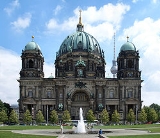
Berliner Dom
Encyclopedia
Berlin Cathedral is the colloquial name for the Evangelical
Oberpfarr- und Domkirche (English analogously: Supreme Parish and Collegiate Church, literally Supreme Parish and Cathedral Church) in Berlin, Germany. It is the parish church of the Evangelical congregation Gemeinde der Oberpfarr- und Domkirche zu Berlin, a member of the umbrella organisation Evangelical Church of Berlin-Brandenburg-Silesian Upper Lusatia
. Its present building is located on Museum Island
in the Mitte
borough.
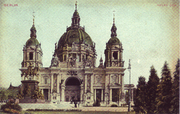 The Berlin Cathedral had never been a cathedral in the actual sense of that term since it has never been the seat of a bishop. The bishop of the Evangelical Church in Berlin-Brandenburg (under this name 1945–2003) is based in St. Mary's Church, Berlin
The Berlin Cathedral had never been a cathedral in the actual sense of that term since it has never been the seat of a bishop. The bishop of the Evangelical Church in Berlin-Brandenburg (under this name 1945–2003) is based in St. Mary's Church, Berlin
, and Kaiser Wilhelm Memorial Church
. St. Hedwig's Cathedral
serves as seat of Berlin's Roman Catholic metropolitan bishop
.
of Brandenburg
moved with his residence from Brandenburg upon Havel to Cölln
(today's Fishers' Island, the southern part of Museum Island) into the newly erected Berlin Castle, which also housed a Catholic castle chapel. In 1454 Frederick Irontooth, after having returned – via Rome – from his pilgrimage to Jerusalem, elevated the castle chapel to become a parish church, richly endowing it with relics and altars. Pope Nicholas V
ordered Stephan Bodecker
, then Prince-Bishop of Brandenburg
, to consecrate the Chapel to Erasmus of Formiae
.
On 7 April 1465 – at Frederick Irontooth's request – Pope Paul II
attributed to St Erasmus Chapel a canon-law
College
named Stift zu Ehren Unserer Lieben Frauen, des heiligen Kreuzes, St. Petri und Pauli, St. Erasmi und St. Nicolai dedicated to Mary(am) of Nazareth, the Holy Cross
, Simon Peter, Paul of Tarsus
, Erasmus of Formiae
, and Nicholas of Myra. A collegiate church is a church endowed with revenues and earning estates, in order to provide a number of canons
, called in canon law
a College
, with prebendaries. In this respect a collegiate church is similar to a cathedral, which is why in colloquial German the term cathedral college (Domstift), became the synecdoche
used – pars pro toto – for all canon-law colleges. So the college of St. Erasmus' chapel, called Domstift in German, bestowed the pertaining church its colloquial naming, Domkirche (cathedral church). Frederick Irontooth provided the College with estates, sufficient to supply prebendaries for eight canons. On 20 January 1469 Dietrich IV, then Prince-Bishop of Brandenburg, invested eight clergymen, chosen by Frederick Irontooth, as collegiate canons with the prebendaries.
reached the consent of Pope Paul III
to shut down the 1297-founded Dominican
convent (Black Friars), southerly neighboured to the castle, to acquire the pertaining monastic St. Paul's Church, built ca. in 1345. On 28 May 1536 most of the Black Friars moved to a Dominican monastery in Brandenburg upon Havel. Joachim II Hector assigned the thus void, three-nave church building to the Collegiate Church of Our Lady, the Holy Cross, the Ss. Peter, Paul, Erasmus and Nicholas and enlarged the College
to 12 prebendaries, bestowing two of them to canons taken on from the Dominican convent. From 1545 on the electoral family of Hohenzollern used the church building also as their burial place.
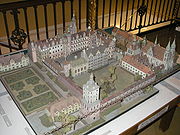 In 1538 a new western façade with two towers was attached to the collegiate church, which – due to its prior status as a church of a mendicant order
In 1538 a new western façade with two towers was attached to the collegiate church, which – due to its prior status as a church of a mendicant order
– had no tower before. In the next year Joachim II Hector converted from Catholicism to Lutheranism
, as earlier had done many of his subjects. The collegiate church thus became Lutheran too, like most of the electoral subjects and all the churches in the Electorate. However, Joachim II Hector's ideas of Reformation
were different from the modern ones. After his conversion he enriched the collegiate church with luxuriant furnishings, such as parament
s, monstrance
s, relic
s, chasuble
s, carpets and antependia
.
In 1608, the year of his accession to the throne, Prince-Elector John Sigismund
, then a crypto-Calvinist, dissolved the college
and the church was renamed into Supreme Parish Church of St. Trinity in Cölln. In 1613 John Sigismund publicly confessed his Calvinist faith (in Germany usually called Reformed Church), but waived his privilege to demand the same of his subjects (Cuius regio, eius religio
). So he and his family, except of his steadfastly Lutheran wife Anna, converted, while most of his subjects remained Lutherans. While Berlin's other churches, subject to Lutheran city-council jurisdiction, remained Lutheran, the Supreme Parish Church of St. Trinity, the Hohenzollern's house church, became Berlin's first, and until 1695 only Calvinist church, serving from 1632 on as the parish for all Calvinists in town. Being now a Calvinist church the patronage of the Holy Trinity was increasingly skipped.
In 1667 the dilapidated double-tower façade was torn down and in 1717 Martin Böhme erected a new baroque
façade with two towers. With effect of 1 January 1710 Cölln was united with Berlin under the latter name. In 1747 the Supreme Parish Church was completely demolished to clear space for the baroque extension of the Berlin Castle.

 On 6 September 1750 the new baroque Calvinist Supreme Parish Church was inaugurated, built by Johann Boumann the Elder in 1747–1750. The electoral tombs were translated to the new building. The new structure covered a space north of the castle, which is still covered by the present building.
On 6 September 1750 the new baroque Calvinist Supreme Parish Church was inaugurated, built by Johann Boumann the Elder in 1747–1750. The electoral tombs were translated to the new building. The new structure covered a space north of the castle, which is still covered by the present building.
In 1817 – under the auspices of King Frederick William III of Prussia
– the community of the Supreme Parish Church, like most Prussian Calvinist and Lutheran congregations joined the common umbrella organisation named Evangelical Church in Prussia (under this name since 1821), with each congregation maintaining its former denomination or adopting the new united denomination. The community of the Supreme Parish Church adopted the new denomination of the Prussian Union
. Today's presbytery of the congregation bears the unusual name in , literally in Cathedral College, thus recalling the history of the church as collegiate church.
In celebration of the Union Karl Friedrich Schinkel
remodelled the interior in the same year and in 1820–1822 the exterior of Boumann's church in the neoclassicist style
. The Supreme Parish and Cathedral Church faced at its southern façade the Berlin Castle, the palace of the Hohenzollern (destroyed in World War II), and the Lustgarten
park at its western front, which is still there.
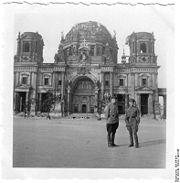 However, in the 19th century a new building was under discussion since long, but the post-Napoléonic poverty made its realisation impossible. After dismantling the movable interior (altar, paintings, sarcophagae), Boumann's building was demolished in 1893 and Julius and Otto Raschdorff, father and son, built the present Supreme Parish and Cathedral Church in exuberant forms of high Neo-Renaissance
However, in the 19th century a new building was under discussion since long, but the post-Napoléonic poverty made its realisation impossible. After dismantling the movable interior (altar, paintings, sarcophagae), Boumann's building was demolished in 1893 and Julius and Otto Raschdorff, father and son, built the present Supreme Parish and Cathedral Church in exuberant forms of high Neo-Renaissance
style.
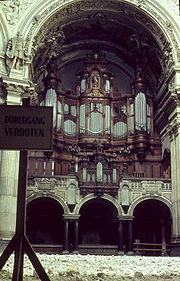 With no separation of Protestant church and state of Prussia
With no separation of Protestant church and state of Prussia
, William II officiated as the summus episcopus (Supreme Governor of the Evangelical State Church of Prussia's older Provinces, as it was named since 1875) and the state paid the complete construction cost of 11,5 million Marks
. At 114 metres (374 ft) long, 73 metres (240 ft) wide and 116 metres (381 ft) tall, it was much larger than any of the previous buildings and was considered a Protestant counterweight to St. Peter's Basilica
in Vatican City. On 27 February 1905 the present building was inaugurated.
In 1940 the blast waves of Allied bombing blew part of the windows away. On 24 May 1944, a bomb of combustible liquids entered the roof lantern
of the dome. The fire could not be extinguished at that unreachable section of the dome. So the lantern burnt out and collapsed into the main floor. Between 1949 and 1953 a temporary roof was built to enclose the building. On 9 May 1967 the then still undivided Evangelical Church of the Union decided a committee for the reconstruction of the Supreme Parish and Cathedral Church, then located in East Berlin
. The government of the Eastern German Democratic Republic
did not oppose the work of the committee due to the concomitant inflow of Deutsche Marks. In 1975 reconstruction started, simplifying the building's original design and tearing down the northern wing (the memorial hall). In 1980 the baptistery
and wedding church was reopened for services. The restoration of the main prayer hall was begun in 1984. On 6 June 1993 the big prayer hall was reinaugurated in an event attended by Federal Chancellor Helmut Kohl
and televised nationwide in Germany.
, built by Wilhelm Sauer, was fully restored during reconstruction. It has 113 stops, including three ranks of 32' pipes on the pedal division, played by a 4-manual console:
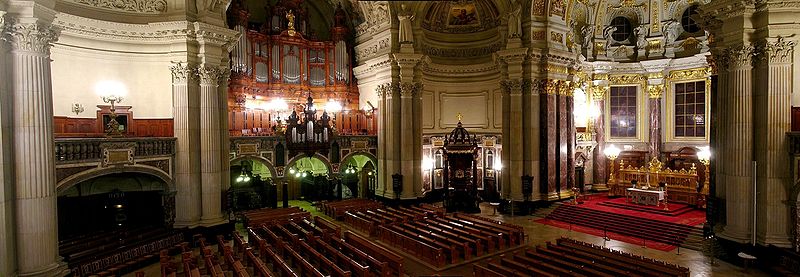
Evangelical Church in Germany
The Evangelical Church in Germany is a federation of 22 Lutheran, Unified and Reformed Protestant regional church bodies in Germany. The EKD is not a church in a theological understanding because of the denominational differences. However, the member churches share full pulpit and altar...
Oberpfarr- und Domkirche (English analogously: Supreme Parish and Collegiate Church, literally Supreme Parish and Cathedral Church) in Berlin, Germany. It is the parish church of the Evangelical congregation Gemeinde der Oberpfarr- und Domkirche zu Berlin, a member of the umbrella organisation Evangelical Church of Berlin-Brandenburg-Silesian Upper Lusatia
Evangelical Church of Berlin-Brandenburg-Silesian Upper Lusatia
The Evangelical Church Berlin-Brandenburg-Silesian Upper Lusatia is a Protestant church body in the German states of Brandenburg, Berlin and a part of Saxony. The seat of the church is in Berlin. It is the most important Protestant denomination in the area....
. Its present building is located on Museum Island
Museum Island
Museum Island is the name of the northern half of an island in the Spree river in the central Mitte district of Berlin, Germany, the site of the old city of Cölln...
in the Mitte
Mitte
Mitte is the first and most central borough of Berlin. It was created in Berlin's 2001 administrative reform by the merger of the former districts of Mitte proper, Tiergarten and Wedding; the resulting borough retained the name Mitte. It is one of the two boroughs which comprises former West and...
borough.

St. Mary's Church, Berlin
St. Mary's Church, known in German as the Marienkirche, is a church in Berlin, Germany. The church is located on Karl-Liebknecht-Straße in central Berlin, near Alexanderplatz. Its exact age is not known, but it was first mentioned in German chronicles in 1292. It is presumed to date from earlier...
, and Kaiser Wilhelm Memorial Church
Kaiser Wilhelm Memorial Church
The Protestant Kaiser Wilhelm Memorial Church is located in Berlin on the Kurfürstendamm in the centre of the Breitscheidplatz. The original church on the site was built in the 1890s. It was badly damaged in a bombing raid in 1943...
. St. Hedwig's Cathedral
St. Hedwig's Cathedral
St. Hedwig's Cathedral is a Roman Catholic cathedral on the Bebelplatz in Berlin, Germany. It is the seat of the archbishop of Berlin.It was built in the 18th century as the first Catholic church in Prussia after the Protestant Reformation by permission of King Frederick II...
serves as seat of Berlin's Roman Catholic metropolitan bishop
Metropolitan bishop
In Christian churches with episcopal polity, the rank of metropolitan bishop, or simply metropolitan, pertains to the diocesan bishop or archbishop of a metropolis; that is, the chief city of a historical Roman province, ecclesiastical province, or regional capital.Before the establishment of...
.
Establishment of a Collegiate Church in Berlin (1451–1536)
The history of today's Supreme Parish and Collegiate Church and its community dates back to 1451. In that year Prince-Elector Frederick II IrontoothFrederick II, Elector of Brandenburg
Frederick II of Brandenburg , nicknamed "the Iron" and sometimes "Irontooth" , was a Prince-elector of the Margraviate of Brandenburg from 1440 until his abdication in 1470, and was a member of the House of Hohenzollern.-Biography:Frederick II was born in Tangermünde to Frederick I, Brandenburg's...
of Brandenburg
Margraviate of Brandenburg
The Margraviate of Brandenburg was a major principality of the Holy Roman Empire from 1157 to 1806. Also known as the March of Brandenburg , it played a pivotal role in the history of Germany and Central Europe....
moved with his residence from Brandenburg upon Havel to Cölln
Cölln
In the 13th century Cölln was the sister town of Old Berlin , located on the southern Spree Island in the Margraviate of Brandenburg. Today the island is located in the historic core of the central Mitte locality of modern Berlin...
(today's Fishers' Island, the southern part of Museum Island) into the newly erected Berlin Castle, which also housed a Catholic castle chapel. In 1454 Frederick Irontooth, after having returned – via Rome – from his pilgrimage to Jerusalem, elevated the castle chapel to become a parish church, richly endowing it with relics and altars. Pope Nicholas V
Pope Nicholas V
Pope Nicholas V , born Tommaso Parentucelli, was Pope from March 6, 1447 to his death in 1455.-Biography:He was born at Sarzana, Liguria, where his father was a physician...
ordered Stephan Bodecker
Stephan Bodecker
Stephan Bodecker was the 37th Bishop of Brandenburg and a Christian Hebraist. He is known as the most important of all bishops of Brandenburg....
, then Prince-Bishop of Brandenburg
Bishop of Brandenburg
The Bishopric of Brandenburg was a Roman Catholic diocese established by Otto the Great in 948, including the territory between the Elbe on the west, the Oder on the east, and the Schwarze Elster on the south, and taking in the Uckermark to the north. Its seat was Brandenburg upon Havel...
, to consecrate the Chapel to Erasmus of Formiae
Erasmus of Formiae
Saint Erasmus of Formiae was a Christian saint and martyr who died ca. 303, also known as Saint Elmo. He is venerated as the patron saint of sailors...
.
On 7 April 1465 – at Frederick Irontooth's request – Pope Paul II
Pope Paul II
Pope Paul II , born Pietro Barbo, was pope from 1464 until his death in 1471.- Early life :He was born in Venice, and was a nephew of Pope Eugene IV , through his mother. His adoption of the spiritual career, after having been trained as a merchant, was prompted by his uncle's election as pope...
attributed to St Erasmus Chapel a canon-law
Canon law
Canon law is the body of laws & regulations made or adopted by ecclesiastical authority, for the government of the Christian organization and its members. It is the internal ecclesiastical law governing the Catholic Church , the Eastern and Oriental Orthodox churches, and the Anglican Communion of...
College
College (canon law)
A college, in the canon law of the Roman Catholic Church, is a collection of persons united together for a common object so as to form one body. The members are consequently said to be incorporated, or to form a corporation.-History:...
named Stift zu Ehren Unserer Lieben Frauen, des heiligen Kreuzes, St. Petri und Pauli, St. Erasmi und St. Nicolai dedicated to Mary(am) of Nazareth, the Holy Cross
Christian cross
The Christian cross, seen as a representation of the instrument of the crucifixion of Jesus Christ, is the best-known religious symbol of Christianity...
, Simon Peter, Paul of Tarsus
Paul of Tarsus
Paul the Apostle , also known as Saul of Tarsus, is described in the Christian New Testament as one of the most influential early Christian missionaries, with the writings ascribed to him by the church forming a considerable portion of the New Testament...
, Erasmus of Formiae
Erasmus of Formiae
Saint Erasmus of Formiae was a Christian saint and martyr who died ca. 303, also known as Saint Elmo. He is venerated as the patron saint of sailors...
, and Nicholas of Myra. A collegiate church is a church endowed with revenues and earning estates, in order to provide a number of canons
Canon (priest)
A canon is a priest or minister who is a member of certain bodies of the Christian clergy subject to an ecclesiastical rule ....
, called in canon law
Canon law
Canon law is the body of laws & regulations made or adopted by ecclesiastical authority, for the government of the Christian organization and its members. It is the internal ecclesiastical law governing the Catholic Church , the Eastern and Oriental Orthodox churches, and the Anglican Communion of...
a College
College (canon law)
A college, in the canon law of the Roman Catholic Church, is a collection of persons united together for a common object so as to form one body. The members are consequently said to be incorporated, or to form a corporation.-History:...
, with prebendaries. In this respect a collegiate church is similar to a cathedral, which is why in colloquial German the term cathedral college (Domstift), became the synecdoche
Synecdoche
Synecdoche , meaning "simultaneous understanding") is a figure of speech in which a term is used in one of the following ways:* Part of something is used to refer to the whole thing , or...
used – pars pro toto – for all canon-law colleges. So the college of St. Erasmus' chapel, called Domstift in German, bestowed the pertaining church its colloquial naming, Domkirche (cathedral church). Frederick Irontooth provided the College with estates, sufficient to supply prebendaries for eight canons. On 20 January 1469 Dietrich IV, then Prince-Bishop of Brandenburg, invested eight clergymen, chosen by Frederick Irontooth, as collegiate canons with the prebendaries.
The Collegiate Church Residing in the former Black Friars' Church of St. Paul's south of the Castle (1536–1747)
In 1535 Prince-Elector Joachim II HectorJoachim II Hector, Elector of Brandenburg
Joachim II Hector was a Prince-elector of the Margraviate of Brandenburg . A member of the House of Hohenzollern, Joachim II was the son of Joachim I Nestor, Elector of Brandenburg, and his wife Elizabeth of Denmark, Norway, and Sweden...
reached the consent of Pope Paul III
Pope Paul III
Pope Paul III , born Alessandro Farnese, was Pope of the Roman Catholic Church from 1534 to his death in 1549. He came to the papal throne in an era following the sack of Rome in 1527 and rife with uncertainties in the Catholic Church following the Protestant Reformation...
to shut down the 1297-founded Dominican
Dominican Order
The Order of Preachers , after the 15th century more commonly known as the Dominican Order or Dominicans, is a Catholic religious order founded by Saint Dominic and approved by Pope Honorius III on 22 December 1216 in France...
convent (Black Friars), southerly neighboured to the castle, to acquire the pertaining monastic St. Paul's Church, built ca. in 1345. On 28 May 1536 most of the Black Friars moved to a Dominican monastery in Brandenburg upon Havel. Joachim II Hector assigned the thus void, three-nave church building to the Collegiate Church of Our Lady, the Holy Cross, the Ss. Peter, Paul, Erasmus and Nicholas and enlarged the College
College (canon law)
A college, in the canon law of the Roman Catholic Church, is a collection of persons united together for a common object so as to form one body. The members are consequently said to be incorporated, or to form a corporation.-History:...
to 12 prebendaries, bestowing two of them to canons taken on from the Dominican convent. From 1545 on the electoral family of Hohenzollern used the church building also as their burial place.

Mendicant Orders
The mendicant orders are religious orders which depend directly on the charity of the people for their livelihood. In principle, they do not own property, either individually or collectively , believing that this was the most pure way of life to copy followed by Jesus Christ, in order that all...
– had no tower before. In the next year Joachim II Hector converted from Catholicism to Lutheranism
Lutheranism
Lutheranism is a major branch of Western Christianity that identifies with the theology of Martin Luther, a German reformer. Luther's efforts to reform the theology and practice of the church launched the Protestant Reformation...
, as earlier had done many of his subjects. The collegiate church thus became Lutheran too, like most of the electoral subjects and all the churches in the Electorate. However, Joachim II Hector's ideas of Reformation
Protestant Reformation
The Protestant Reformation was a 16th-century split within Western Christianity initiated by Martin Luther, John Calvin and other early Protestants. The efforts of the self-described "reformers", who objected to the doctrines, rituals and ecclesiastical structure of the Roman Catholic Church, led...
were different from the modern ones. After his conversion he enriched the collegiate church with luxuriant furnishings, such as parament
Parament
A Parament or Parement; , a term applied by ancient writers to the hangings or ornaments of a room of state. Later it has referred to the liturgical hangings on and around the altar, as well as the cloths hanging from the pulpit and lectern, as well as the ecclesiastical vestments and mitres...
s, monstrance
Monstrance
A monstrance is the vessel used in the Roman Catholic, Old Catholic, and Anglican churches to display the consecrated Eucharistic host, during Eucharistic adoration or Benediction of the Blessed Sacrament. Created in the medieval period for the public display of relics, the monstrance today is...
s, relic
Relic
In religion, a relic is a part of the body of a saint or a venerated person, or else another type of ancient religious object, carefully preserved for purposes of veneration or as a tangible memorial...
s, chasuble
Chasuble
The chasuble is the outermost liturgical vestment worn by clergy for the celebration of the Eucharist in Western-tradition Christian Churches that use full vestments, primarily in the Roman Catholic, Anglican and Lutheran churches, as well as in some parts of the United Methodist Church...
s, carpets and antependia
Antependia
An antependium , more commonly known as a hanging, or, when speaking specifically of the hanging for the altar, an altar frontal , is a decorative piece of material that can adorn a Christian altar, lectern, pulpit, or table...
.
In 1608, the year of his accession to the throne, Prince-Elector John Sigismund
John Sigismund, Elector of Brandenburg
John Sigismund was a Prince-elector of the Margraviate of Brandenburg from the House of Hohenzollern. He also served as a Duke of Prussia.-Elector of Brandenburg and Duke of Prussia:...
, then a crypto-Calvinist, dissolved the college
College (canon law)
A college, in the canon law of the Roman Catholic Church, is a collection of persons united together for a common object so as to form one body. The members are consequently said to be incorporated, or to form a corporation.-History:...
and the church was renamed into Supreme Parish Church of St. Trinity in Cölln. In 1613 John Sigismund publicly confessed his Calvinist faith (in Germany usually called Reformed Church), but waived his privilege to demand the same of his subjects (Cuius regio, eius religio
Cuius regio, eius religio
Cuius regio, eius religio is a phrase in Latin translated as "Whose realm, his religion", meaning the religion of the ruler dictated the religion of the ruled...
). So he and his family, except of his steadfastly Lutheran wife Anna, converted, while most of his subjects remained Lutherans. While Berlin's other churches, subject to Lutheran city-council jurisdiction, remained Lutheran, the Supreme Parish Church of St. Trinity, the Hohenzollern's house church, became Berlin's first, and until 1695 only Calvinist church, serving from 1632 on as the parish for all Calvinists in town. Being now a Calvinist church the patronage of the Holy Trinity was increasingly skipped.
In 1667 the dilapidated double-tower façade was torn down and in 1717 Martin Böhme erected a new baroque
Baroque architecture
Baroque architecture is a term used to describe the building style of the Baroque era, begun in late sixteenth century Italy, that took the Roman vocabulary of Renaissance architecture and used it in a new rhetorical and theatrical fashion, often to express the triumph of the Catholic Church and...
façade with two towers. With effect of 1 January 1710 Cölln was united with Berlin under the latter name. In 1747 the Supreme Parish Church was completely demolished to clear space for the baroque extension of the Berlin Castle.
The Supreme Parish Church Residing in its new Building north of the Castle (1750–1893)


In 1817 – under the auspices of King Frederick William III of Prussia
Frederick William III of Prussia
Frederick William III was king of Prussia from 1797 to 1840. He was in personal union the sovereign prince of the Principality of Neuchâtel .-Early life:...
– the community of the Supreme Parish Church, like most Prussian Calvinist and Lutheran congregations joined the common umbrella organisation named Evangelical Church in Prussia (under this name since 1821), with each congregation maintaining its former denomination or adopting the new united denomination. The community of the Supreme Parish Church adopted the new denomination of the Prussian Union
Prussian Union (Evangelical Christian Church)
The Prussian Union was the merger of the Lutheran Church and the Reformed Church in Prussia, by a series of decrees – among them the Unionsurkunde – by King Frederick William III...
. Today's presbytery of the congregation bears the unusual name in , literally in Cathedral College, thus recalling the history of the church as collegiate church.
In celebration of the Union Karl Friedrich Schinkel
Karl Friedrich Schinkel
Karl Friedrich Schinkel was a Prussian architect, city planner, and painter who also designed furniture and stage sets. Schinkel was one of the most prominent architects of Germany and designed both neoclassical and neogothic buildings.-Biography:Schinkel was born in Neuruppin, Margraviate of...
remodelled the interior in the same year and in 1820–1822 the exterior of Boumann's church in the neoclassicist style
Neoclassical architecture
Neoclassical architecture was an architectural style produced by the neoclassical movement that began in the mid-18th century, manifested both in its details as a reaction against the Rococo style of naturalistic ornament, and in its architectural formulas as an outgrowth of some classicizing...
. The Supreme Parish and Cathedral Church faced at its southern façade the Berlin Castle, the palace of the Hohenzollern (destroyed in World War II), and the Lustgarten
Lustgarten
The Lustgarten is a park on Museum Island in central Berlin, near the site of the former Berliner Stadtschloss of which it was originally a part...
park at its western front, which is still there.
The Supreme Parish and Cathedral Church Residing in the Present Building (1905 to date)

Neo-Renaissance
Renaissance Revival is an all-encompassing designation that covers many 19th century architectural revival styles which were neither Grecian nor Gothic but which instead drew inspiration from a wide range of classicizing Italian modes...
style.

Kingdom of Prussia
The Kingdom of Prussia was a German kingdom from 1701 to 1918. Until the defeat of Germany in World War I, it comprised almost two-thirds of the area of the German Empire...
, William II officiated as the summus episcopus (Supreme Governor of the Evangelical State Church of Prussia's older Provinces, as it was named since 1875) and the state paid the complete construction cost of 11,5 million Marks
German gold mark
The Goldmark was the currency used in the German Empire from 1873 to 1914.-History:Before unification, the different German states issued a variety of different currencies, though most were linked to the Vereinsthaler, a silver coin containing 16⅔ grams of pure silver...
. At 114 metres (374 ft) long, 73 metres (240 ft) wide and 116 metres (381 ft) tall, it was much larger than any of the previous buildings and was considered a Protestant counterweight to St. Peter's Basilica
St. Peter's Basilica
The Papal Basilica of Saint Peter , officially known in Italian as ' and commonly known as Saint Peter's Basilica, is a Late Renaissance church located within the Vatican City. Saint Peter's Basilica has the largest interior of any Christian church in the world...
in Vatican City. On 27 February 1905 the present building was inaugurated.
In 1940 the blast waves of Allied bombing blew part of the windows away. On 24 May 1944, a bomb of combustible liquids entered the roof lantern
Roof lantern
A roof lantern is a daylighting cupola architectural element. Architectural lanterns are atop a larger roof and provide natural light into the space or room below. In contemporary use it is an architectural skylight structure...
of the dome. The fire could not be extinguished at that unreachable section of the dome. So the lantern burnt out and collapsed into the main floor. Between 1949 and 1953 a temporary roof was built to enclose the building. On 9 May 1967 the then still undivided Evangelical Church of the Union decided a committee for the reconstruction of the Supreme Parish and Cathedral Church, then located in East Berlin
East Berlin
East Berlin was the name given to the eastern part of Berlin between 1949 and 1990. It consisted of the Soviet sector of Berlin that was established in 1945. The American, British and French sectors became West Berlin, a part strongly associated with West Germany but a free city...
. The government of the Eastern German Democratic Republic
German Democratic Republic
The German Democratic Republic , informally called East Germany by West Germany and other countries, was a socialist state established in 1949 in the Soviet zone of occupied Germany, including East Berlin of the Allied-occupied capital city...
did not oppose the work of the committee due to the concomitant inflow of Deutsche Marks. In 1975 reconstruction started, simplifying the building's original design and tearing down the northern wing (the memorial hall). In 1980 the baptistery
Baptistery
In Christian architecture the baptistry or baptistery is the separate centrally-planned structure surrounding the baptismal font. The baptistry may be incorporated within the body of a church or cathedral and be provided with an altar as a chapel...
and wedding church was reopened for services. The restoration of the main prayer hall was begun in 1984. On 6 June 1993 the big prayer hall was reinaugurated in an event attended by Federal Chancellor Helmut Kohl
Helmut Kohl
Helmut Josef Michael Kohl is a German conservative politician and statesman. He was Chancellor of Germany from 1982 to 1998 and the chairman of the Christian Democratic Union from 1973 to 1998...
and televised nationwide in Germany.
The Main Organ in the Supreme Parish and Cathedral Church
The pipe organPipe organ
The pipe organ is a musical instrument that produces sound by driving pressurized air through pipes selected via a keyboard. Because each organ pipe produces a single pitch, the pipes are provided in sets called ranks, each of which has a common timbre and volume throughout the keyboard compass...
, built by Wilhelm Sauer, was fully restored during reconstruction. It has 113 stops, including three ranks of 32' pipes on the pedal division, played by a 4-manual console:
|
|
|
|
|
- II/I, III/I, IV/I, Super I, III/II, IV/II, Super II, IV/III, I/P, II/P, III/P, IV/P
- 3 Freie Kombinationen, Mezzoforte, Forte, Tutti, Rohrwerke, Jalousieschweller III. Manual, Jalousieschweller IV. Manual, Jalousieschweller Vox humana, Handregister ab, Rückpositiv ab.

External links
- Berlin Cathedral (history, description, visitor information).
- Berlin Cathedral – Panorama
- Berlin Cathedral, its destruction and restoration
- Berlin webcam including view of Berlin Cathedral and the Palace of the Republic
- Three-dimensional view of Berlin Cathedral (without plugin english, german, spanish)

